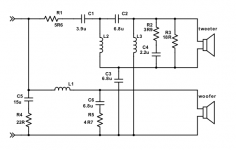Deep EQ notch in the tweeter leg (possibly quite high Q, can't tell w/o values).
Values are listed?
I'm curious as to the origin of this circuit.
Dynaudio Special 40
A guy in the Diy group drew it up for me.
Hi,
The bridge topology L2-C3 and L3-C2 actually is a passive delay network (Lattice phase equaliser - Wikipedia). 🙂
The bridge topology L2-C3 and L3-C2 actually is a passive delay network (Lattice phase equaliser - Wikipedia). 🙂
Values are listed?
Not the inductor values, which is what I presume Draki meant.
So this is a 1st order filter topology in Dynaudio's view?🙄
It looks more like a typical 2nd/3rd order electrical -> 4th order acoustical crossover with some timing compensation, which are also supported by the measurements.
Specs:
Special Forty anniversary standmount speakers - Dynaudio
Measurements, look at the typical 2-way 4th order step response:
Dynaudio Special Forty loudspeaker Measurements | Stereophile.com
It looks more like a typical 2nd/3rd order electrical -> 4th order acoustical crossover with some timing compensation, which are also supported by the measurements.
Specs:
Special Forty anniversary standmount speakers - Dynaudio
Measurements, look at the typical 2-way 4th order step response:
Dynaudio Special Forty loudspeaker Measurements | Stereophile.com
The woofer has a damped 12dB electrical network (ie- coil plus zobel), and the tweeter has a 1st order electrical with ladder delay plus some padding and a tilt down via the CR filter.
The CR in front of the circuit 15uF/22 ohm lends to having a rising system impedance without it. With a CR across both the woofer and tweeter, this would not be the case, save for a lowpass induced rise or an impedance peak at Fo in lieu of the xover. Having that CR directly across the amplifier terminals should likely have a higher power resistor in tow to keep it from over heating. I would think those 2 components could be omitted as all they are doing is changing the impedance of the system. Typically an LCR is used for this purpose to suppress xover impedance humps, and far reduced bandwidth flows through the circuit if a LCR vs a CR is used.
Later,
Wolf
The CR in front of the circuit 15uF/22 ohm lends to having a rising system impedance without it. With a CR across both the woofer and tweeter, this would not be the case, save for a lowpass induced rise or an impedance peak at Fo in lieu of the xover. Having that CR directly across the amplifier terminals should likely have a higher power resistor in tow to keep it from over heating. I would think those 2 components could be omitted as all they are doing is changing the impedance of the system. Typically an LCR is used for this purpose to suppress xover impedance humps, and far reduced bandwidth flows through the circuit if a LCR vs a CR is used.
Later,
Wolf
The woofer has a damped 12dB electrical network (ie- coil plus zobel), and the tweeter has a 1st order electrical with ladder delay plus some padding and a tilt down via the CR filter.
The CR in front of the circuit 15uF/22 ohm lends to having a rising system impedance without it. With a CR across both the woofer and tweeter, this would not be the case, save for a lowpass induced rise or an impedance peak at Fo in lieu of the xover. Having that CR directly across the amplifier terminals should likely have a higher power resistor in tow to keep it from over heating. I would think those 2 components could be omitted as all they are doing is changing the impedance of the system. Typically an LCR is used for this purpose to suppress xover impedance humps, and far reduced bandwidth flows through the circuit if a LCR vs a CR is used.
Later,
Wolf
This, of course, is correct. Not a deep notch EQ in the tweeter leg, but a delay lattice. I should have used the zoom (and not watched Euro qualifiers at the same time)...
If the RC in the woofer circuit was impedance compensation (Zobel) then it would be pure first order. However the resistor is 4r7, so whether this is a 4 or 8 ohm woofer may make the difference there.
The tweeter has a non-flat impedance so it is more difficult to tell.
The tweeter has a non-flat impedance so it is more difficult to tell.
- Status
- Not open for further replies.
- Home
- Loudspeakers
- Multi-Way
- Crossover questions
